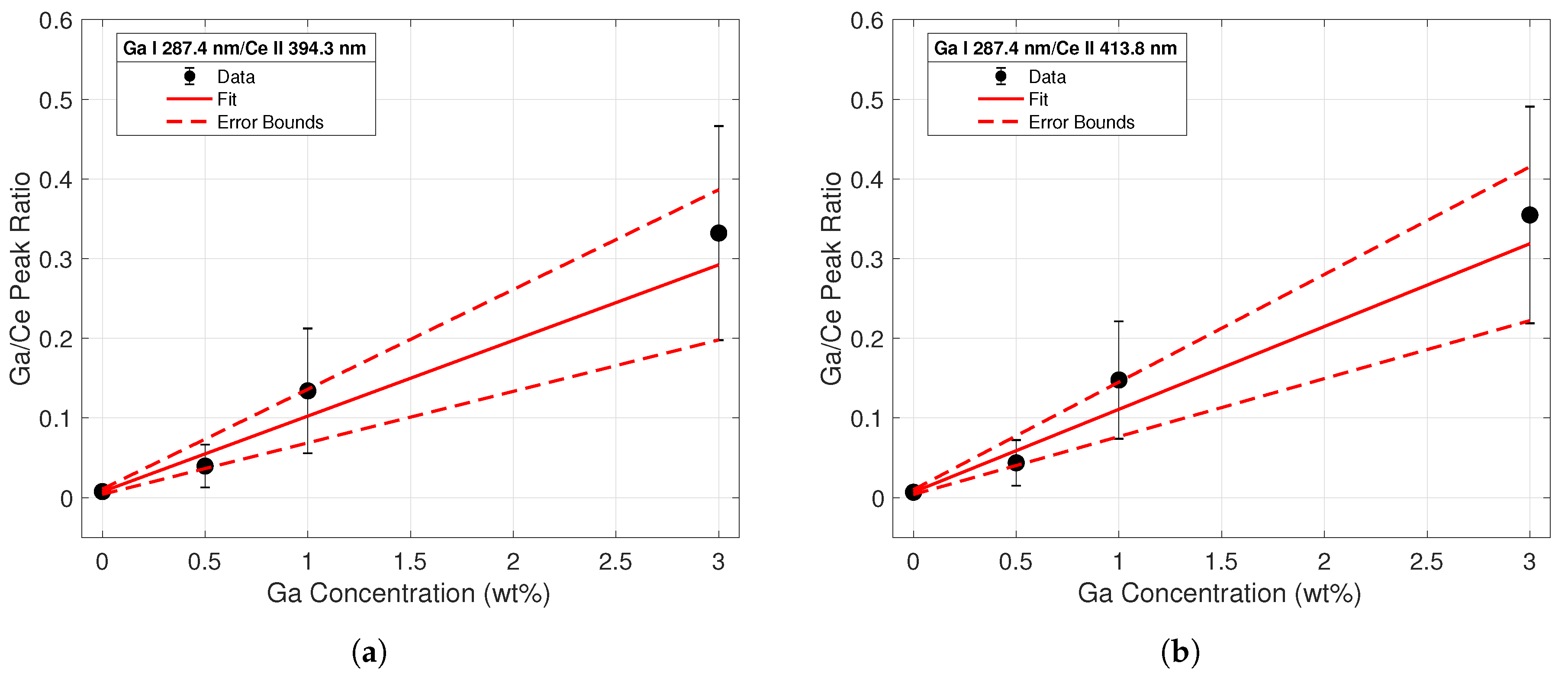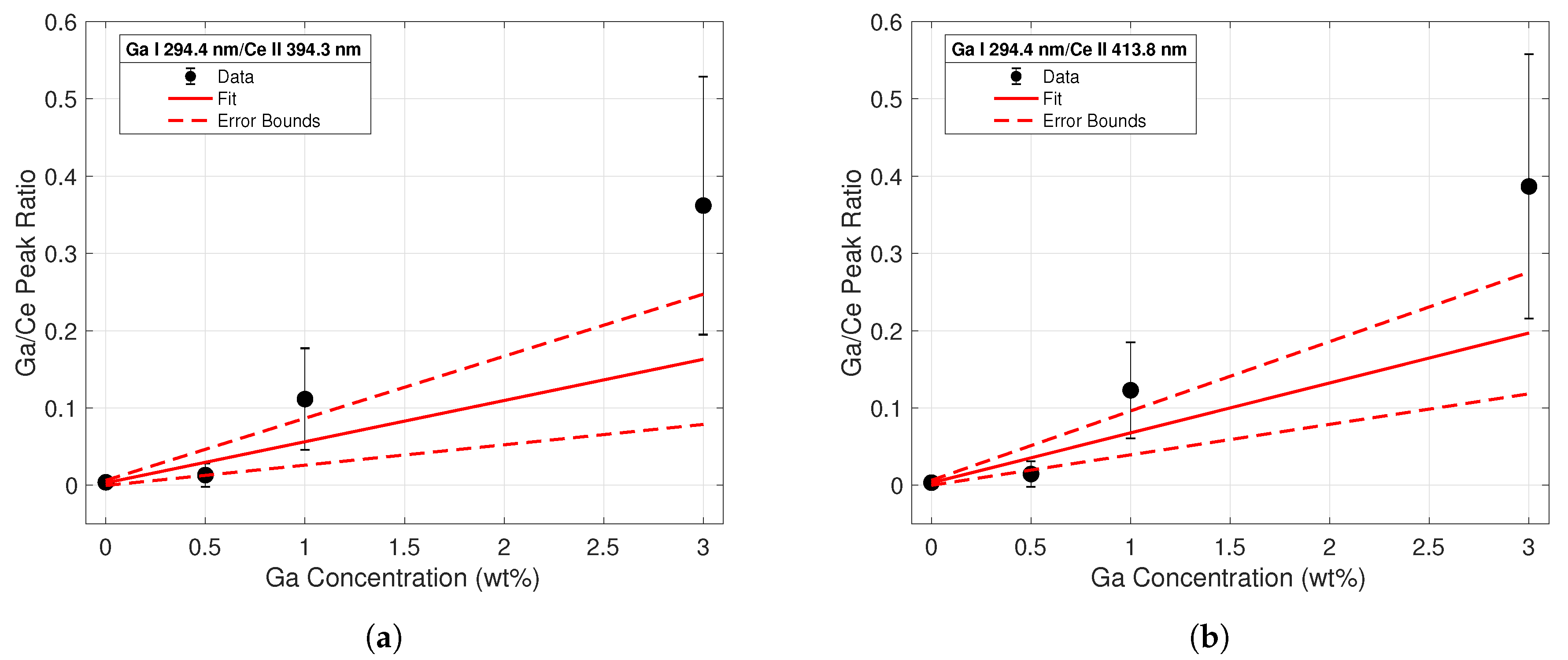Quantitative Analysis of Cerium-Gallium Alloys Using a Hand-Held Laser Induced Breakdown Spectroscopy Device
Abstract
:1. Introduction
2. Sample Manufacturing
3. Spectral Acquisition and Pre-Processing
4. Analytical Line Selection
5. Univariate Calibration Curves and Limits of Detection
6. Multivariate Analysis
7. Concentration Mapping
8. Conclusions
Author Contributions
Funding
Acknowledgments
Conflicts of Interest
References
- Bhatt, B.; Hudson Angeyo, K.; Dehayem-Kamadjeu, A. LIBS development methodology for forensic nuclear materials analysis. Anal. Methods 2018, 10, 791–798. [Google Scholar] [CrossRef]
- Barefield, J.E.; Judge, E.J.; Campbell, K.R.; Colgan, J.P.; Kilcrease, D.P.; Johns, H.M.; Wiens, R.C.; Mcinroy, R.E.; Martinez, R.K.; Clegg, S.M. Analysis of geological materials containing uranium using laser-induced breakdown spectroscopy. Spectrochim. Acta B 2016, 120, 1–8. [Google Scholar] [CrossRef] [Green Version]
- Klus, J.; Mikysek, P.; Prochazka, D.; Porizka, P.; Prochazková, P.; Novotny, J.; Trojek, T.; Novotny, K.; Slobodník, M.; Kaiser, J. Multivariate approach to the chemical mapping of uranium in sandstone-hosted uranium ores analyzed using double pulse laser-induced breakdown spectroscopy. Spectrochim. Acta B 2016, 123, 143–149. [Google Scholar] [CrossRef]
- Sirven, J.; Pailloux, A.; Baye, Y.; Coulon, N.; Alpettaz, T.; Gosse, S. Towards the determination of the geographical origin of yellow cake samples by laser-induced breakdown spectroscopy and chemometrics. J. Anal. At. Spectrom. 2009, 24, 451–459. [Google Scholar] [CrossRef]
- Kim, Y.; Han, B.; Shin, H.S.; Kim, H.D.; Jung, E.C.; Jung, J.H.; Na, S.H. Determination of uranium concentration in an ore sample using laser-induced breakdown spectroscopy. Spectrochim. Acta B 2012, 75, 190–193. [Google Scholar] [CrossRef]
- Shattan, M.B.; Gragston, M.; Zhang, Z.; John, D.; Auxier, I.; McIntosh, K.G.; Parigger, C.G. Mapping of Uranium in Surrogate Nuclear Debris Using Laser-Induced Breakdown Spectroscopy (LIBS). Appl. Spectrosc. 2019, 73, 591–600. [Google Scholar] [CrossRef] [PubMed]
- Chinni, R.; Cremers, D.A.; Multari, R. Analysis of material collected on swipes using laser-induced breakdown spectroscopy. Appl. Opt. 2010, 49, C143–C152. [Google Scholar] [CrossRef]
- Sarkar, A.; Alamelu, D.; Aggarwal, S.K. Determination of thorium and uranium in solution by laser-induced breakdown spectrometry. Appl. Opt. 2008, 4, G58–G64. [Google Scholar] [CrossRef] [PubMed]
- Gaona, I.; Serrano, J.; Moros, J.; Laserna, J.J. Evaluation of laser-induced breakdown spectroscopy analysis potential for addressing radiological threats from a distance. Spectrochim. Acta B 2014, 96, 12–20. [Google Scholar] [CrossRef]
- Harilal, S.; Brumfield, B.; LaHaye, N.; Hartig, K.; Phillips, M. Optical spectroscopy of laser-produced plasmas for standoff isotopic analysis. Appl. Phys. Rev. 2018, 5, 021301. [Google Scholar] [CrossRef]
- SciAps. SciAps Z Brochure. 2014. Available online: https://www.sciaps.com/wp-content/uploads/2014/08/Z-brochureRGB.pdf (accessed on 21 July 2019).
- Shattan, M.B.; Miller, D.J.; Cook, M.T.; Stowe, A.C.; Auxier, J.D.; Parigger, C.; Hall, H.L. Detection of uranyl fluoride and sand surface contamination on metal substrates by hand-held laser-induced breakdown spectroscopy. Appl. Opt. 2017, 56, 9868–9875. [Google Scholar] [CrossRef]
- Manard, B.T.; Wylie, E.M.; Willson, S.P. Analysis of Rare Earth Elements in Uranium Using Handheld Laser-Induced Breakdown Spectroscopy (HH LIBS). Appl. Spectrosc. 2018, 72, 1653–1660. [Google Scholar] [CrossRef] [PubMed] [Green Version]
- Marra, J. Cerium as a Surrogate in the Plutonium Immobilized Form; International Atomic Energy Agency (IAEA): Vienna, Austria, 2001. [Google Scholar]
- Moore, M.; Tao, Y. Aerosol Physics Considerations for Using Cerium Oxide CeO2 as a Surrogate for Plutonium Oxide PuO2 in Airborne Release Fraction Measurements for Storage Container Investigations; Los Alamos National Lab. (LANL): Los Alamos, NM, USA, 2017. [Google Scholar]
- Zheng, H.; Yueh, F.Y.; Miller, T.; Singh, J.; Zeigler, K.E.; Marra, J.C. Analysis of plutonium oxide surrogate residue using laser-induced breakdown spectroscopy. Spectrochim. Acta B 2008, 63, 968–974. [Google Scholar] [CrossRef]
- Gibbs, F.E.; Olson, D.L.; Hutchinson, W. Identification of a physical metallurgy surrogate for the plutonium—1 wt.% gallium alloy. AIP Conf. Proc. 2000, 532, 98–101. [Google Scholar] [CrossRef]
- FY2015 Performance Evaluation Report; Technical Report; NNSA: Washington, DC, USA, 2015.
- Steinzig, M.; Harlow, F.H. Characterization Of Cast Metals With Probability Distribution Functions. MRS Proc. 1999, 538. [Google Scholar] [CrossRef]
- Hecker, S.S. Plutonium: Coping with instability. JOM 2003, 55, 13–19. [Google Scholar] [CrossRef]
- Söderlind, P.; Zhou, F.; Landa, A.; Klepeis, J. Phonon and magnetic structure in δ-plutonium from density-functional theory. Sci. Rep. 2015, 5, 15958. [Google Scholar] [CrossRef]
- Johnson, C.G. Metallurgy, 4th ed.; American Technical Society: Chicago, IL, USA, 1956. [Google Scholar]
- Rai, A.K.; Yueh, F.Y.; Singh, J.P. Laser-induced breakdown spectroscopy of molten aluminum alloy. Appl. Opt. 2003, 42, 2078–2084. [Google Scholar] [CrossRef]
- Noll, R.; Sturm, V.; Aydin, Ü.; Eilers, D.; Gehlen, C.; Höhne, M.; Lamott, A.; Makowe, J.; Vrenegor, J. Laser-induced breakdown spectroscopy—From research to industry, new frontiers for process control. Spectrochim. Acta Part B At. Spectrosc. 2008, 63, 1159–1166. [Google Scholar] [CrossRef]
- Gruber, J.; Heitz, J.; Arnold, N.; Bäuerle, D.; Ramaseder, N.; Meyer, W.; Hochörtler, J.; Koch, F. In situ Analysis of Metal Melts in Metallurgic Vacuum Devices by Laser-Induced Breakdown Spectroscopy. Appl. Spectrosc. 2004, 58, 457–462. [Google Scholar] [CrossRef]
- Schulze, G.; Jirasek, A.; Yu, M.M.L.; Lim, A.; Turner, R.F.B.; Blades, M.W. Investigation of Selected Baseline Removal Techniques as Candidates for Automated Implementation. Appl. Spectrosc. 2005, 59, 545–574. [Google Scholar] [CrossRef] [PubMed]
- Press, W.H.; Flannery, B.P.; Teukolsky, S.A.; Vetterling, W.T. Numerical Recipes in C: The Art of Scientific Computing, 2nd ed.; Cambridge University Press: Cambridge, UK, 1992. [Google Scholar]
- Guo, G.; Niu, G.; Shi, Q.; Lin, Q.; Tian, D.; Duan, Y. Multi-element quantitative analysis of soils by laser induced breakdown spectroscopy (LIBS) coupled with univariate and multivariate regression methods. Anal. Methods 2019, 11, 3006–3013. [Google Scholar] [CrossRef]
- Gottfried, J.L.; Harmon, R.S.; Lucia, F.C.D.; Miziolek, A.W. Multivariate analysis of laser-induced breakdown spectroscopy chemical signatures for geomaterial classification. Spectrochim. Acta B 2009, 64, 1009–1019. [Google Scholar] [CrossRef]
- Tiwari, P.K.; Awasthi, S.; Kumar, R.; Anand, R.K.; Rai, P.K.; Rai, A.K. Rapid analysis of pharmaceutical drugs using LIBS coupled with multivariate analysis. Lasers Med. Sci. 2018, 33, 263–270. [Google Scholar] [CrossRef] [PubMed]
- Larose, D.; Larose, C. Data Mining and Predictive Analysis; Wiley: Hoboken, NJ, USA, 2015. [Google Scholar]
- Predel, B. Ce-Ga (Cerium-Gallium). In Ca-Cd–Co-Zr; Springer: Berlin/Heidelberg, Germany, 1993; pp. 1–3. [Google Scholar] [CrossRef]








| Line Ratio | a | a | b | b | R | LOD (wt%) |
|---|---|---|---|---|---|---|
| 287.4 nm/394.3 nm | 0.098 | 0.0294 | 0.0072 | 0.0036 | 0.9669 | 0.335 |
| 287.4 nm/413.8 nm | 0.106 | 0.0320 | 0.0066 | 0.0032 | 0.9661 | 0.318 |
| 294.4 nm/394.3 nm | 0.053 | 0.0251 | 0.0029 | 0.0033 | 0.4855 | 3.524 |
| 294.4 nm/413.8 nm | 0.063 | 0.0243 | 0.003 | 0.0033 | 0.5637 | 3.429 |
| Parameter | Value |
|---|---|
| b | 0.006 |
| b | 2.934 |
| b | 5.886 |
| b | 0.001 |
| b | 0.341 |
| b | 0.333 |
| R | 0.994 |
© 2019 by the authors. Licensee MDPI, Basel, Switzerland. This article is an open access article distributed under the terms and conditions of the Creative Commons Attribution (CC BY) license (http://creativecommons.org/licenses/by/4.0/).
Share and Cite
Rao, A.P.; Cook, M.T.; Hall, H.L.; Shattan, M.B. Quantitative Analysis of Cerium-Gallium Alloys Using a Hand-Held Laser Induced Breakdown Spectroscopy Device. Atoms 2019, 7, 84. https://doi.org/10.3390/atoms7030084
Rao AP, Cook MT, Hall HL, Shattan MB. Quantitative Analysis of Cerium-Gallium Alloys Using a Hand-Held Laser Induced Breakdown Spectroscopy Device. Atoms. 2019; 7(3):84. https://doi.org/10.3390/atoms7030084
Chicago/Turabian StyleRao, Ashwin P., Matthew T. Cook, Howard L. Hall, and Michael B. Shattan. 2019. "Quantitative Analysis of Cerium-Gallium Alloys Using a Hand-Held Laser Induced Breakdown Spectroscopy Device" Atoms 7, no. 3: 84. https://doi.org/10.3390/atoms7030084
APA StyleRao, A. P., Cook, M. T., Hall, H. L., & Shattan, M. B. (2019). Quantitative Analysis of Cerium-Gallium Alloys Using a Hand-Held Laser Induced Breakdown Spectroscopy Device. Atoms, 7(3), 84. https://doi.org/10.3390/atoms7030084





